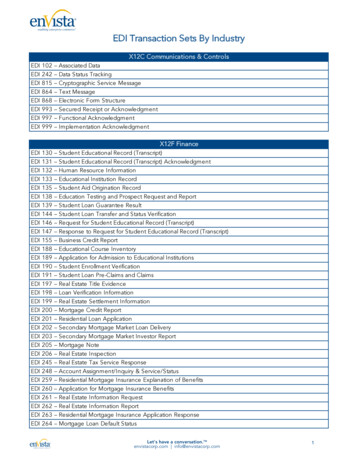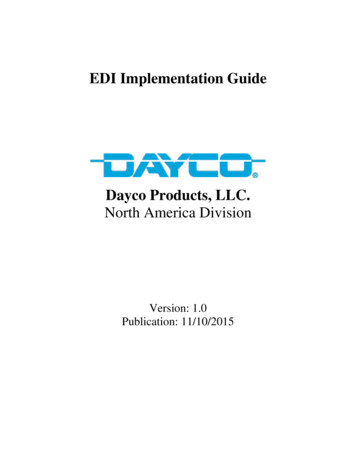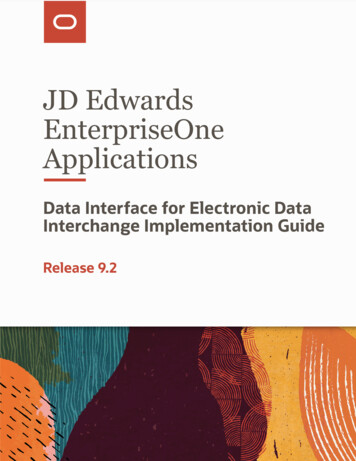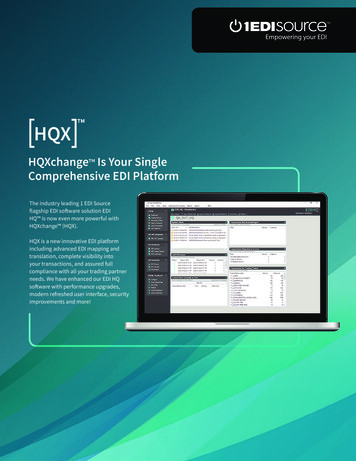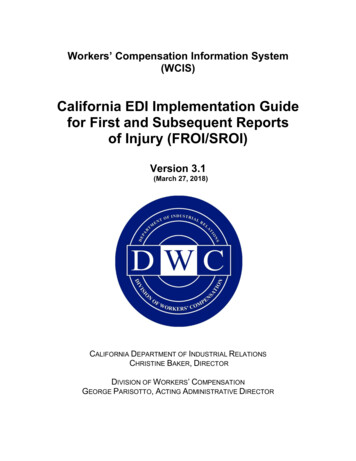
Transcription
Workers’ Compensation Information System(WCIS)California EDI Implementation Guidefor First and Subsequent Reportsof Injury (FROI/SROI)Version 3.1(March 27, 2018)CALIFORNIA DEPARTMENT OF INDUSTRIAL RELATIONSCHRISTINE BAKER, DIRECTORDIVISION OF WORKERS’ COMPENSATIONGEORGE PARISOTTO, ACTING ADMINISTRATIVE DIRECTOR
February 1, 2016Dear Claims Administrators:Welcome to Electronic Data Interchange (EDI). The California Division of Workers’Compensation (DWC) is pleased to introduce its revised system for receiving workers’compensation claims data via EDI. This data will be integrated with related industry datato make up our Workers’ Compensation Information System, which is becoming a richresource for analyzing the performance of California’s workers’ compensation system.This revised manual, the California EDI Implementation Guide For First and SubsequentReports of Injury, is intended to be a primary resource for the organizations thatcomprise the Division’s “trading partners” – claims administrators for California workers’compensation claims.Most reporting organizations already have substantial experience with EDI, and transmitdata to workers’ compensation agencies in many states. For them, this ImplementationGuide can serve as a reference for California-specific protocols. While we have adheredto national EDI standards, California’s implementation does have minor differences fromother states’ protocols.The Implementation Guide also includes background information for organizations newto EDI. If your organization is just getting started, the “Overview of EDI” and the“Managers’ Guide” are for you. You will also find numerous valuable resource materials.This Implementation Guide will remain under development for some time. As both theDivision and our EDI trading partners gain experience with California’s EDI system,updates to the Guide will be posted on our Web site athttp://www.dir.ca.gov/dwc/wcis.htm.I hope that, if you are new to reporting via EDI, your start-up of reporting in California willbe as smooth and as painless as possible, both for the Division and for our EDI tradingpartners. DWC is dedicated to full, open communication as a cornerstone of asuccessful start-up process, and this Implementation Guide is a key element of thatcommunication.Sincerely,GEORGE PARISOTTOActing Administrative Director(March 27, 2018)ii
Table of ContentsWelcome to Electronic Data Interchange (EDI) . iiSection A: EDI in California – An Overview .1EDI – Electronic Data Interchange . 1California’s WCIS – the Workers’ Compensation Information System. 2California EDI Requirements . 3Sending Data to the WCIS . 3Section B: Where to Get Help – Contacting WCIS and Other InformationResources . 5California Division of Workers’ Compensation . 5EDI Service Providers . 6IAIABC . 7Section C: Implementing EDI – A Managers’ Guide. 8Section D: Authorizing Statutes – Labor Code sections 138.6 and 138.7 . 12Labor Code section 138.6 Development of workers’ compensation information system 12Labor Code section 138.7 “Individually identifiable information”; restricted access. . 12Section E: Legal Authorities . 16Section F: Trading Partner Profile . 18Section G: Test, Pilot, and Production Phases of EDI . 29Step 1. Complete an EDI Trading Partner Profile . 29Step 2. Complete the Test Phase. 31Step 3. Complete the Pilot Phase. 35Step 4. Production . 39Section H: File Formats and Supported Transactions . 42Section I: The SFTP (SSH (Secure Shell) File Transfer Protocol)Transmission Mode . 43Data Transmission with SFTP (SSH (Secure Shell) File Transfer Protocol) . 43Transmission Pathways . 46Section J: Events that Trigger Required EDI Reports . 47First Report of Injury . 47Subsequent Report of Injury . 48Annual Summary . 49(March 27, 2018)iii
Section K: Required Data Elements . 50WCIS Data Requirement Codes. 51Data Requirements for First Reports of Injury . 52FROI Conditional Rules and Implementation Notes . 55Data Requirements for Subsequent Report of Injury . 58SROI Conditional Rules and Implementation Notes . 62Section L: California-Specific Data Edits Adopted IAIABC Data ElementLists . 66All Transactions . 66First Reports (FROIs) . 66Subsequent Reports (SROIs) . 68FROI Data Elements, Sorted by Data Element Number (DN) . 69SROI Data Elements, Sorted By Data Element Number (DN) . 73Section M: System Specifications . 76Agency Claim Number/Jurisdiction Claim Number (JCN) . 76Changed or Corrected Data . 76Transaction Processing and Sequencing . 76General Rules . 76First Reports . 78First Report Transaction Sequencing Requirements Summary . 79Subsequent Reports . 79Transaction Sequencing Requirements for Subsequent Reports . 82Sequencing Rules . 82Related Business Rules . 82WCIS Matching Rules and Processes . 83FROI Matching Process for Original ‘00’ MTC . 84FROI Matching Process for Cancel ‘01’ MTC . 85FROI Matching Process for Change ‘02’ or Correction ‘CO’ MTC . 86FROI Matching Process for Denial ‘04’ MTC . 87FROI Matching Process for Acquired Claim ‘AU’ MTC . 88SROI Matching Process for All SROI MTCs . 89Section N: Code Lists . 90Nature of Injury Codes (DN35) . 90Part of Body Codes (FROI DN36) and SROI (DN83) . 90Cause of Injury Codes (DN37) . 90Late Reason Codes (DN77) . 90Class Codes (DN59) . 91
Payment/Adjustment and Paid to Date (DN85 and DN95) Benefit Type Codes . 92Industry Codes (DN25) . 93Section O: EDI Terminology . 94Abbreviations and Acronyms . 94EDI Glossary. 95Appendix A: Revised WCIS System Updates . 99Differences Between Version 3.0 and Version 3.1 of WCIS FROI/SROI . 100Differences Between Version 2.1 and Version 3.0 of WCIS: . 102Differences Between Version 2.0 and Version 2.1 of WCIS: . 104Appendix B: Revision History – Summary of Principal Changes fromPrevious Versions. 107Version 3.1. 107Version 3.0. 109Version 2.1. 110Version 2.0. 112Version 1.2. 114Version 1.1. 115Version 1.02. 115Version 1.01. 116Version 1.00. 116
(March 27, 2018)iv
California EDI Implementation Guide for First and Subsequent Reports of Injury (FROI/SROI)Section ASection A: EDI in California – An OverviewEDI – Electronic Data InterchangeElectronic Data Interchange (EDI) is the computer-to-computer exchange of dataor information in a standardized format. In workers’ compensation, EDI refers tothe electronic transmission of claims information from claims administrators(insurers, self-insured employers, and third party administrators) to a StateWorkers’ Compensation Agency.Data are transmitted in a format standardized by the International Association ofIndustrial Accident Boards and Commissions (IAIABC). The IAIABC is aprofessional association of workers’ compensation specialists from the public andprivate sectors and has spearheaded the introduction of EDI in workers’compensation. All collected data elements are reviewed for valid andstandardized business definitions and formats.Benefits of EDI within Workers’ Compensation Allows state agencies to respond to policy makers’ questions regardingtheir state programsElectronic data interchange allows states to evaluate the effectiveness andefficiency of their workers’ compensation system by providing comprehensiveand readily accessible information on all claims. This information can then bemade available to state policy makers considering any changes to thesystem. Avoids costs in paper handlingElectronic data interchange reduces costs in the processing of paperdocuments for the claims administrator and the jurisdiction: mail processingcosts, duplicated data entry costs, shipping, filing and storage costs. Increases data qualityElectronic data interchange has built-in data quality checking procedures thatare triggered when data are received by the state agency. Many claimsadministrators choose to replicate these data-checking procedures to reducethe cost of data correction. Simplifies reporting requirements for multi-state insurersElectronic data interchange helps claims administrators cut costs by having asingle system for internal data management and reporting.(March 27, 2018)1
California EDI Implementation Guide for First and Subsequent Reports of Injury (FROI/SROI)Section ACalifornia’s WCIS – the Workers’ Compensation Information SystemHistoryThe California Legislature enacted sweeping reforms to California’s workers’compensation system in 1993. The reform legislation was preceded by avigorous debate among representatives of injured workers, their employers,insurance companies, and medical providers. All parties agreed that changeswere due, but they could not reach agreement on the nature of the problems tobe corrected nor on the likely impact of alternative reform proposals. One barrierto well-informed debate was the absence of comprehensive, impartial informationabout the performance of California’s workers’ compensation system.Foreseeing the strengths and weaknesses of the system, the Legislature directedthe Division of Workers’ Compensation (DWC) to put together comprehensiveinformation about workers’ compensation in California. The result is the WCIS-the Workers’ Compensation Information System. The WCIS has been indevelopment since 1995, and its design has been shaped by a broad-basedadvisory committee. The WCIS has four main objectives: help DWC manage the workers’ compensation system efficiently andeffectively, facilitate the evaluation of the benefit delivery system, assist in measuring benefit adequacy, provide statistical data for further research.WCIS Data CollectionThe core of the system is standardized data on every California workers’compensation claim. Much of this data has historically been collected in paperform: employers’ and physicians’ first reports of injury and benefit notices.Beginning in 2000, standardized data was transmitted to the WCIS by EDI.These EDI transmissions are the main subject of this Guide. EDI reportingallows DWC to understand and improve the California workers’ compensationsystem.(March 27, 2018)2
California EDI Implementation Guide for First and Subsequent Reports of Injury (FROI/SROI)Section ACalifornia EDI RequirementsCalifornia’s WCIS regulations define EDI reporting requirements for claimsadministrators. A claims administrator is an insurer, a self-insured employer, or athird-party administrator.In brief, claims administrators are required to submit the following:First Reports: First Reports of Injury (FROIs) must be submitted by EDI to WCISin the Division of Workers’ Compensation (DWC) no later than 10 business daysafter claim administrator knowledge of the claim.Subsequent Reports: Subsequent Reports of Injury (SROIs) are submittedwithin 15 business days whenever benefit payments to an employee are started,changed, suspended, restarted, stopped, delayed or denied or when a claim isclosed, or upon notification of employee representation.Medical Bill/Payment Records: Medical bill payment reporting regulationsrequire medical services with a date of service on or after September 22, 2006and a date of injury on or after March 1, 2000 to be transmitted to the DWCwithin 90 calendar days of the medical bill payment or the date of the finaldetermination that payment for billed medical services would be denied. Thesemedical services are required to be reported to the WCIS by all claimsadministrators handling 150 or more total claims per year.Annual Summary of Benefits: An Annual Summary of Benefits must besubmitted for every claim with any benefit activity (including medical) during thepreceding calendar year. The annual summary report is due by January 31 andmust report the cumulative totals of any benefits paid as of December 31 of thepreceding calendar year.Sending Data to the WCISWorkers’ compensation claims are handled by diverse organizations: large multistate insurance companies, smaller specialty insurance carriers, self-insuredemployers, and third-party administrators handling claims on behalf of insuredand self-insured employers. These organizations have different informationsystems and capabilities. The WCIS has been designed to be as flexible aspossible in the support of a variety of EDI systems.The allowed methods of transmitting data from claim administrators to WCIS is: SFTP also known as SSH (Secure Shell) File Transfer Protocol(March 27, 2018)3
California EDI Implementation Guide for First and Subsequent Reports of Injury (FROI/SROI)Section AThe electronic communications options are described more fully in Section H–File Formats and Supported Transactions and Section I–Transmission Modes.The WCIS is also flexible in supporting two different file formats, known asAmerican National Standards Institute (ANSI) X12 and “flat-file” formats.Claim administrators can avoid the details of EDI by selecting among severalfirms that sell EDI-related software products, consulting, and related services.Injured WorkerInsurerSelf-Insured/Administered EmployerThird-Party AdministratorEmployerOptionalAlternativeClaim AdministratorEDI Service BureauWCISDepartment of Industrial Relations(March 27, 2018)4
California EDI Implementation Guide for First and Subsequent Reports of Injury (FROI/SROI)Section BSection B: Where to Get Help – Contacting WCIS andOther Information ResourcesStarting up a new EDI system isn’t simple. It requires detailed technicalinformation, as well as close cooperation between the organizations that senddata, the trading partners and the organization that receives data, the CaliforniaDivision of Workers’ Compensation (DWC). The following is a list of resourcesavailable for information and assistance.California Division of Workers’ CompensationOur Web SiteVisit our web site at http://www.dir.ca.gov/dwc/WCIS.htm to: Download the latest version of the California EDI Implementation Guidefor First and Subsequent Reports of Injury (FROI/SROI), Get answers to Frequently Asked Questions, Review archived WCIS e·News letters.Your WCIS Contact PersonEach WCIS Trading Partner will be assigned a WCIS contact person at DWC.This person will help answer your questions about EDI reporting in California,work with you during the Test-Pilot-Production process, and be an ongoingsource of support during production.Your WCIS liaison can be reached by phone, e-mail, or mail. When initiallycontacting us, be sure to provide your company name so that you may bedirected to the appropriate WCIS staff.By phone:(510)286-1263 Trading Partner Letters C, G-H, M, P-R(510)286-6763 Trading Partner Letters B, D-F, N-O, W-Y(510)286-6772 Trading Partner Letters A, I-L, S-V, ZBy e-mail:wcis@dir.ca.govBy mail:WCIS EDI UnitAttn: Name of WCIS Contact (if known)Department of Industrial Relations1515 Clay St.Oakland, CA 94612If you find errors or omissions in the California EDI Implementation Guide(FROI/SROI), please inform your WCIS contact person.(March 27, 2018)5
California EDI Implementation Guide for First and Subsequent Reports of Injury (FROI/SROI)Section BWCIS e·NewsWCIS e·News is an e-mail newsletter sent out periodically to inform WCISTrading Partners of announcements and technical implementations. The WCISe·News will be archived on the WCIS web site. Interested parties who are notalready receiving WCIS e·News can register by sending an email towcis@dir.ca.gov with the subject, “Subscribe e-News”.WCIS Training BulletinsWCIS Training Bulletins are informational e-mails issued by DWC to helpimprove data quality for the most common errors in WCIS reporting. The WCISTraining Bulletins are archived on the WCIS web site. Interested parties who arenot already receiving WCIS Training Bulletins can register by sending an email towcis@dir.ca.gov with the subject, “Subscribe Training Bulletin”.EDI Service ProvidersSeveral companies can assist you in your efforts to report data via EDI. A rangeof products and services are available, including: software that works with your organization’s computer systems toautomatically transmit data, systems consulting, to help get your computer systems EDI-ready, data transcription services which accept paper forms, keypunch data,and transmit the data via EDI.A list of companies known to DWC that provide these services can be found athttp://www.dir.ca.gov/DWC/EDIvend.HTM.Claims administrators seeking assistance in implementing EDI may wish toconsult one or more of the EDI service providers listed on the DWC website.Many of these firms offer a full range of EDI-related services: consultation,technical support, value added network (VAN) services, and/or softwareproducts. These products and services can make it possible for claimsadministrators to successfully transmit claims data via EDI and avoid thetechnical details of EDI.Another alternative to developing a complete EDI system is to contract for theservices of a data collection agent. For a fee, a data collection agent will receivepaper forms by fax or mail, enter the data, and transmit it by EDI to stateagencies or other electronic commerce trading partners.The California Division of Workers’ Compensation does not have a process forgranting “approvals” to any EDI service providers. Listings of providers, which arefound on the Division’s website, are simply of providers known to the Division.The lists will be updated as additional resources become known.Appearance on the EDI service provider lists does not in any wayconstitute an endorsement of the companies listed or a guarantee of the(March 27, 2018)6
California EDI Implementation Guide for First and Subsequent Reports of Injury (FROI/SROI)Section Bservices they provide. Other companies not listed may be equally capableof providing EDI-related services.Note to suppliers of EDI-related services: Please contact wcis@dir.ca.gov if youwish to have your organization added or removed from DWC’s list, or to updateyour contact information.IAIABCThe International Association of Industrial Accident Boards and Commissions(IAIABC) is the organization that sets the national standards for the transmissionof workers’ compensation claims data via EDI. The IAIABC publishes thesestandards in their EDI Implementation Guide.For more information about the IAIABC and how to purchase the IAIABC EDIImplementation Guide, visit the IAIABC web site at http://www.iaiabc.org. TheWCIS follows the IAIABC Release 1 reporting standard.(March 27, 2018)7
California EDI Implementation Guide for First and Subsequent Reports of Injury (FROI/SROI)Section CSection C: Implementing EDI – A Managers’ Guide1.Get to know the basic requirements.Starting up a new EDI system can be a complex endeavor. Make sure youunderstand all that is required before investing resources. Otherwise, youmay end up with a collection of piecemeal fixes rather than acomprehensive solution.This guide and the IAIABC guide contain much of the information needed toimplement EDI in California. As more information becomes available it willbe posted on our Web site at http://www.dir.ca.gov/dwc/WCIS.htm.2.Assign responsibilities for implementing EDI.Some organizations put an Information Systems (IS) manager in charge,while others designate a claims manager. Implementing EDI will affect yourinformation system, flow of claims information and your business process.The most effective approach may be to have Claims and InformationSystems departments collaborate on the project.Regardless of who is assigned primary responsibility, make sure that bothClaims and IS departments maintain continual oversight as your solution isdesigned and implemented.3.Decide whether to contract with an EDI service provider.Formatting electronic records and transmitting them by EDI generallyrequires some specialized automated routines. Programming a completeEDI system also requires in-depth knowledge of EDI standards andprotocols.Some organizations choose to develop these routines in-house, especially ifthey have an IS department that is familiar with EDI and is efficient inbringing new technology online.Other organizations choose to contract with vendors for dedicated EDIsoftware or services. Typically, an EDI vendor’s products interface withyour organization’s data to produce EDI transactions in the requiredformats. The benefit is that no one in your organization has to learn all theintricacies of EDI. The service provider takes care of file formats, recordlayouts, and many other details that may seem foreign to your organization.Some EDI vendors can also provide full-service consulting, helping youupdate your entire data management process for electronic commerce.A list of known EDI vendors can be found on the DWC ch 27, 2018)8
California EDI Implementation Guide for First and Subsequent Reports of Injury (FROI/SROI)4.Section CIf your organization will not use an EDI service provider, choose a fileformat and transmission mode for your data.Contracting with an EDI service provider would relieve your organization ofthe detailed mechanics of EDI, such as file formats and transmissionmodes. If you decide to develop your own system, you will have someimportant decisions to make that will determine the scope and difficulty ofthe programming work.Probably the most important decision is whether your data will be packagedas “flat files” or as “ANSI X12 files.” More information on these choices isprovided in Section H–File Formats and Supported Transactions. Ingeneral, Release 1 flat files are relatively easy to get up and runningquickly. ANSI X12 may be a wise investment in long-run flexibility andcompatibility.Information about file formats can be found in the IAIABC EDI Release 1Implementation Guide, at http://www.iaiabc.org. This guide is essential ifyou will be programming your own EDI system.You will also need to support the SFTP transmission mode that WCISrequires. See Section I, the SFTP Transmission Mode, for furtherinformation.5.Make sure your computer systems contain all the required data.You’ll have a hard time submitting data by EDI if the data are not readilyaccessible on your systems. Give your Information Systems department acopy of Section K–Required Data Elements.If all are available and readily accessible, then you are in great shape. Ifnot, your Claims and IS departments will need to develop and implement aplan for capturing, storing, and accessing the necessary data.6.Determine who will handle error messages sent by WCIS.Your organization will receive “error messages” from WCIS if you transmitdata that cannot be interpreted or do not meet the regulatory requirementsto provide complete, valid and accurate data.Some glitches are inevitable. You’ll need a system for forwarding any errormessages to people who can respond as necessary.Establish a procedure for responding to error messages before you begintransmitting data by EDI. Otherwise, your organization may find itselfunprepared for the inevitable.Typically, errors related to technical problems may be aggravating when asystem is new, but they quickly become rare. Error messages related todata quality and completeness are harder to correct, and you can expectthem to present an ongoing workload that must be managed.(March 27, 2018)9
California EDI Implementation Guide for First and Subsequent Reports of Injury (FROI/SROI)7.Section CDecide whether your organization could benefit by adding data edits.Data you transmit to the WCIS will be subjected to edit rules to assure thatthe data are valid and consistent with data previously reported for aparticular claim. For example, one edit rule would reject an injury date ofFebruary 31. Another rule would reject a benefit notice if a First Report hadnot been previously filed. These edit rules are detailed in Section K–Required Data Elements, Section L–Cal
California EDI Implementation Guide for First and Subsequent Reports of Injury (FROI/SROI) Section A (March 27, 2018) 1 . Section A: EDI in California - An Overview . EDI - Electronic Data Interchange Electronic Data Interchange (EDI) is the computer-to-computer exchange of data or information in a standardized format.

